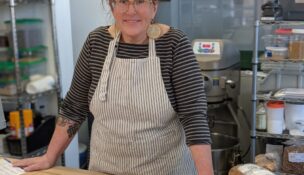Cattle Call on the Eastern Plains
Flying Diamond Ranch builds land stewardship into business model
Allen Best //February 4, 2019//


Cattle Call on the Eastern Plains
Flying Diamond Ranch builds land stewardship into business model
Allen Best //February 4, 2019//

To understand the business model of the Flying Diamond Ranch near Kit Carson, on Colorado’s Eastern Plains, it’s useful to revisit the hunting expedition there in 1872 by the third son of the Russian czar. Grand Duke Alexis wanted to kill buffalo.
Feted in Denver, where the 22-year-old heir inspired lust among the new city’s young maidens, Alex rode on the new railroad to Kit Carson, 150 miles southeast of the mile-high town. He was accompanied by Gen. Phil Sheridan, the key figure in the War Department’s effort to make the country safe for homesteaders, and Gen. George Custer.
On his way west, young Alex had met with William F. Cody, who already was known as Buffalo Bill after killing 4,280 buffalo during a 17-month span. Near Kit Carson, on land that very well may have later become the Flying Diamond, the grand duke emulated Cody, shooting five. He was so excited upon making his first kill that he kissed Custer.
Custer met his end in 1876, and just a decade later, only 1,000 bison remained in all of North America from the giant herds of bison. In their place came long-horned cattle driven north from Mexico. Among the herders was a youngster, in family lore a runaway of just 15, named Charles Collins.
Today, his great-great grandson, Charles Collins Johnson, ranches that land along Big Sandy Creek with his three older siblings, all in their 20s and 30s, and their parents, Scott and Jean Johnson. Electric wires now tightly restrict movement of cattle where the buffalo once roamed amid the sea of sand, sage and native gamma grasses. But in one critical way, nothing has changed. The Flying Diamond’s bovine business begins with grass.
“We’re land managers, not cattle managers,” Jean Johnson says. “There’s a mental switch that occurs when you think your crop is grass. If you call yourself a cattle ranch, all you see are cows.”
To grow grass, you need sunshine, which Colorado has in abundance. Water can be another matter. Big Sandy Creek rarely carries water. Ten wells in the alluvial aquifer deliver water via 20-plus miles of pipe to 23 stock tanks. There’s not enough water for other purposes, such as growing alfalfa. The ranch gets only what falls from the sky, typically 13 to 14 inches a year, probably about as much as when the buffalo roamed.
In grazing the Great Plains, bison moved in giant herds, to reduce predation. They grazed the grasses intensively but infrequently. The intense grazing benefitted the grasses, but so did the long rests. That’s what the grazing regime on the Flying Diamond seeks to replicate.
Scott Johnson instituted this grazing regime after taking over management in 1990. He had nurtured the idea after spending several days in 1986 with noted ecologist Allan Savory, an advocate of holistic management of grazing lands. Applied at the Flying Diamond’s 23,000 acres of deeded land and 1,900 acres of leased land around Kit Carson, holistic management requires electric wire, a human on-site presence and careful planning.
“We’re farming the land with our cow combine,” Scott’s son, Charlie, says as he drives a pickup to one of the pastures, called a paddock, 280 acres in size. The land is grazed uniformly low, but the cattle — black and red Angus composites — know something is up. They are about to be released to another pasture, set off by some of the 100 miles of electric fence on the Flying Diamond’s home ranch. Cattle are moved every four days. The 1,000 cows and their 1,000 yearlings have access to just 5 percent of the ranch at any one time.
“We hope we are building soil health,” says Charlie’s sister, Jen Livsey, who lives in Wheat Ridge but oversees the ranch’s rotational grazing plan and, like all family members, participates in periodic work weekends at the ranch. “Healthy land is a carbon sink and a water sponge.”
Industrial agriculture of the 20th century relies heavily on what are called “inputs,” such as fertilizer, herbicides and pesticides. In the Flying Diamond view, that’s an added — and unnecessary — expense. The guiding philosophy is to get as much for free as possible.
“Deer and antelope spend zero dollars, and their offspring have a 50 percent survival rate,” Livsey says as the cattle hurry to their next pasture. At the Flying Diamond, she says, the goal is to improve the odds, but mimic nature to lower costs. The goal is a 20 percent return on investment.
“When we go to Disney World, it comes on the backs of the cattle,” Scott Johnson says.
Beef and cattle continue to drive Colorado’s ag economy, accounting for 67 percent of the total value of agriculture production and $3.4 billion in cash receipts, according to the 2019 Colorado Business Economic Outlook. The report points out that consumer demand for beef remains strong and will only increase as incomes rise in developing countries. But 2018 was a tough year for many beef producers, as nearly half the state was in extreme to exceptional drought.
After 111 years of markets’ ups and downs, droughts and bounty, the Johnson family members believe the Flying Diamond demonstrates that ranching can be a viable business. “You can make money in the cattle business, and we expect to make money in the cattle business,” Livsey says.
Charlie Johnson says their father has reinvested half the profits from the ranch back into the ranch for nearly 30 years. The other half goes into other investments: commercial real estate in Denver and Phoenix, the stock market, oil exploration and other opportunities. “The results he has seen have been 5 to 10 percent better on the dollars reinvested in the ranch than investment elsewhere,” Charlie says.
Although the cattle are grass-fed and organic, that remains a niche market, good for only 10 percent of the cattle, Scott Johnson says. The rest are shipped when they are about 500 pounds to feedlots to be fattened on corn.
The Flying Diamond has been saluted several times for its environmental stewardship. In 2015, the Sand County Foundation awarded it the Leopold Conservation Award. The award remembers “Sand County Almanac” author Aldo Leopold, who once said, “When we see land as a community to which we belong, we may begin to use it with love and respect.”
To Scott Johnson, though, it’s all business. He rejects the cliched story of ranching and farming. “We don’t play victim,” he says. “We are not starving to death.” He needs no government handouts, he insists. “This is America. If we can’t make it out here, then we need to go make it someplace else.”
Johnson says the typical agriculture story, no matter who’s in power in Washington, D.C., is about the decline of farms and ranches, about not enough work for the children, who must flee to cities to make a living. “That’s not how we see this,” he says. “We have a responsibility to make this work.”
But in a way, the Flying Diamond comports with many trends. For one thing, it’s gotten bigger, tripling in size during the last eight years. One impetus was the fierce drought year of 2011-2012. Rather than constrict, the family diversified, adding 10,000 acres of deeded lands near Westcliffe and Thatcher and 12,000 leased acres near Castle Rock, Westcliffe, Peyton and Thatcher.
Livsey points out that size is crucial to raising cattle. “It is almost impossible to support a family of four with fewer than 250-300 cows,” she says. In 2012, 57 percent of beef operations in the United States had fewer than 20 cows. These smaller operations are often described as “hobby ranches.” Farmers who grow row crops such as corn and wheat “very rarely are in the business for fun,” she says.
Including the home ranch at Kit Carson, this makes the Johnson family owners of 33,000 deeded acres and 13,000 leased acres — huge compared with ranches of 50 years ago, although not so much today. One of Colorado’s largest ranches, Cross Mountain, west of Craig, has 224,050 acres. Louis Bacon’s Trinchera Ranch in the Sangre de Christo Range has 180,000 acres. John Malone’s Silver Spur Ranch has 150,000 acres. Ranches, like farms, have been getting bigger.
And little prairie towns have been getting smaller. Kit Carson High School had 80 students when Scott Johnson graduated in 1978. In 2010, when Charlie Johnson graduated, there were 28. His child, if she graduates from the school, will likely have even fewer classmates.
Despite living in a Denver suburb, Livsey praises her ranch upbringing. She was the first female graduate of the King Ranch Institute of Ranch Management in Texas, but before that studied at Princeton University, where she competed as a long-distance runner. She grew up running amid the swales of grass and sagebrush, once leaping across a rattlesnake.
Returning to a pasture in August, cattle bawling all around, Livsey reflects on what it means to produce beef on Colorado’s Eastern Plains. “What I really like about ranching is that it’s so real,” she says. “At the end of the day, you have a real product to show for your efforts.”
























